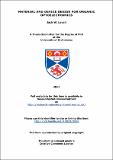Files in this item
Material and device design for organic optoelectronics
Item metadata
| dc.contributor.advisor | Samuel, Ifor D. W. | |
| dc.contributor.author | Levell, Jack William | |
| dc.coverage.spatial | 193 | en_US |
| dc.date.accessioned | 2011-11-24T12:37:38Z | |
| dc.date.available | 2011-11-24T12:37:38Z | |
| dc.date.issued | 2011-11-30 | |
| dc.identifier.uri | https://hdl.handle.net/10023/2066 | |
| dc.description.abstract | This thesis describes investigations into the photophysical properties of luminescent materials and their application in optoelectronic devices such as light emitting diodes and photodetectors. The materials used were all solution processable because of the interest in low cost processing of organics. I have investigated the photophysics of 1,4,5,8,9,12-hexamethyltriphenylene, a triphenylene derivative which has its luminescence enhanced by the addition of methyl groups. These groups change the planar shape of the triphenylene molecule into a twisted one, changing the symmetry of the molecule and increasing its dipole moment in absorption and emission by ~4 fold. This increased its rate of radiative deexcitation by ~20 times. In addition, the twisted shape of the molecule prevents intermolecular interactions and concentration effects from affecting the luminescence. This results in an efficient solid-state photoluminescence quantum yield of 31%. This thesis also includes an investigation into phosphorescent polymer dendrimers, designed to have suitable viscosities in solution for inkjet printed OLED applications. A photophysical study of the intra-chain aggregation effects on the luminescence was undertaken in both homopolymers and copolymers with high energy gap spacer units. Using double dendrons to increase the steric protection of the luminescent cores, the best homopolymers achieved 12.1% external quantum efficiency (39.3 cd/A) at 100 cd/m² brightness and the best co-polymer achieved 14.7% EQE (48.3 cd/A) at 100 cd/m². This compares favourably with 11.8% EQE for the best phosphorescent polymer and 16% for the best solution processed dendrimer OLED previously reported. Finally I have applied a solution processed enhancement layer to silicon photodiodes to enhance their ultraviolet response. Using a blend of materials to give favourable absorption and emission properties, 61% external quantum efficiency was achieved at 200 nm, which is better than the 20-30% typical for vacuum deposited lumogen enhancement layers used commercially. | en_US |
| dc.language.iso | en | en_US |
| dc.publisher | University of St Andrews | |
| dc.rights | Creative Commons Attribution-NoDerivs 3.0 Unported | |
| dc.rights.uri | http://creativecommons.org/licenses/by-nd/3.0/ | |
| dc.subject | Photophysics | en_US |
| dc.subject | Iridium complex | en_US |
| dc.subject | Polymer | en_US |
| dc.subject | Photodiode | en_US |
| dc.subject | Luminescence | en_US |
| dc.subject | Phosphorescent | en_US |
| dc.subject | OLED | en_US |
| dc.subject.lcc | TK8304.L4 | en_US |
| dc.subject.lcsh | Optoelectronic devices--Design and construction | en_US |
| dc.subject.lcsh | Organic compounds--Optical properties | en_US |
| dc.subject.lcsh | Optical materials | en_US |
| dc.subject.lcsh | Photodiodes | en_US |
| dc.title | Material and device design for organic optoelectronics | en_US |
| dc.type | Thesis | en_US |
| dc.type.qualificationlevel | Doctoral | en_US |
| dc.type.qualificationname | PhD Doctor of Philosophy | en_US |
| dc.publisher.institution | The University of St Andrews | en_US |
This item appears in the following Collection(s)
Except where otherwise noted within the work, this item's licence for re-use is described as Creative Commons Attribution-NoDerivs 3.0 Unported
Items in the St Andrews Research Repository are protected by copyright, with all rights reserved, unless otherwise indicated.


